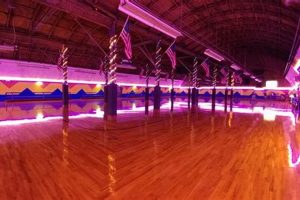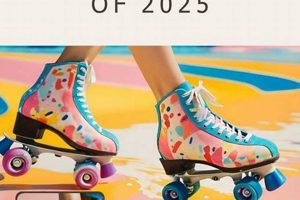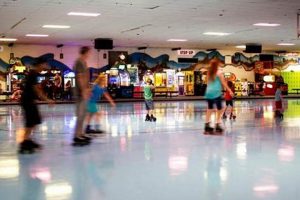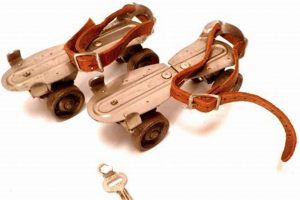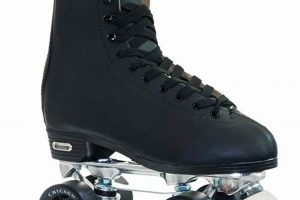The acquisition of pre-owned recreational footwear, specifically those designed with wheels for gliding across surfaces, represents a viable option for individuals seeking an entry point into the sport or a cost-effective alternative to purchasing new equipment. Examples of this include inline models or traditional quad configurations previously owned and offered for resale.
Circulating these goods provides several advantages, including reduced initial expense for participants, promotion of environmentally conscious consumption through reuse, and opportunities for collectors seeking vintage or specific models no longer in production. Historically, such recirculation has facilitated broader participation in recreational activities by making them more accessible to diverse socioeconomic groups.
Subsequent sections of this discussion will address key factors to consider when acquiring equipment of this nature, encompassing aspects such as condition assessment, safety protocols, and market dynamics.
Tips for Acquiring Pre-Owned Rolling Footwear
The following recommendations aim to guide individuals in making informed decisions when procuring wheeled boots that have been previously owned, ensuring both safety and satisfaction.
Tip 1: Assess Structural Integrity: Thoroughly examine the boot for signs of wear and tear, including cracks, tears, or separation of components. Compromised structural integrity can significantly impact safety and performance.
Tip 2: Evaluate Wheel Condition: Inspect the wheels for uneven wear, flat spots, or cracks. Such imperfections can affect the smoothness of the ride and increase the risk of accidents. Replacement may be necessary.
Tip 3: Inspect Bearings: Test the bearings by spinning each wheel individually. Rough or noisy bearings indicate the need for cleaning, lubrication, or replacement. Smooth-running bearings are crucial for efficient gliding.
Tip 4: Verify Closure Mechanisms: Evaluate the functionality of all buckles, straps, and laces. Secure closure mechanisms are essential for providing adequate support and preventing slippage during use.
Tip 5: Check Brake Functionality (if applicable): If the equipment includes a brake, ensure it is in good working order and that the brake pad has sufficient material remaining. Inadequate braking capability poses a safety risk.
Tip 6: Inquire About Usage History: Obtain information regarding the prior usage of the boots, including the frequency of use and the types of surfaces on which they were used. This information can provide insights into the overall condition and potential lifespan.
Tip 7: Prioritize Proper Fit: Attempt to try on the boots, if possible, to ensure a comfortable and secure fit. Ill-fitting equipment can lead to discomfort, blisters, and reduced control.
Adhering to these guidelines can significantly mitigate the risks associated with acquiring and utilizing pre-owned rolling footwear, contributing to a safer and more enjoyable experience.
The subsequent section will delve into the considerations for maintaining and storing rolling footwear to prolong its lifespan.
1. Condition Assessment of Used Roller Skates
Condition assessment is an indispensable element in the evaluation of pre-owned rolling footwear. The state of such equipment directly influences its safety, performance, and longevity. A thorough inspection can reveal hidden damage, wear, or defects that may not be immediately apparent, mitigating potential risks associated with their use. For example, hairline cracks in the boot’s frame, though seemingly insignificant, can propagate under stress, leading to structural failure and potential injury. Similarly, excessive wear on wheels can compromise grip and control, particularly during maneuvers requiring precise movements.
The process of condition assessment involves a multi-faceted approach, encompassing visual inspection, tactile evaluation, and functional testing. Visual inspection focuses on identifying visible signs of damage, such as cracks, tears, and abrasions. Tactile evaluation involves feeling for irregularities in the surface or stiffness in moving parts. Functional testing assesses the performance of key components, including wheels, bearings, and closure mechanisms. For instance, spinning each wheel individually can reveal signs of bearing wear, such as noise or roughness. Testing the closure mechanisms ensures secure fit and prevents slippage during use.
In conclusion, the rigorous condition assessment of pre-owned rolling footwear is not merely a formality but a critical step in ensuring user safety and maximizing the value of the purchase. Overlooking this process can lead to unexpected equipment failures, potential injuries, and ultimately, a less satisfying skating experience. A comprehensive evaluation, combining visual, tactile, and functional assessments, provides a sound basis for making informed decisions regarding the acquisition and use of such equipment.
2. Size and fit
The correlation between size and fit, and the effective utilization of pre-owned rolling footwear is a critical determinant of user experience and safety. The consequences of improper fit range from discomfort and reduced performance to increased risk of injury. Footwear that is too large can result in slippage, diminishing control and increasing the likelihood of falls. Conversely, equipment that is too small can cause constriction, leading to pain, blisters, and potential long-term foot problems. The pre-owned market introduces complexities, as prior usage can alter the original dimensions or shape of the footwear. For example, the inner lining may compress over time, creating a looser fit than initially intended by the manufacturer. Therefore, verification of size and a practical fit assessment are essential prior to use.
Accurate size assessment requires careful measurement of the foot and comparison to the manufacturer’s sizing charts, when available. However, relying solely on numerical size designations can be misleading. Variations in sizing standards across different brands necessitate a physical try-on whenever feasible. The fit should be assessed while wearing socks of the type typically used during skating. Attention should be paid to the heel, instep, and toe box. The heel should be secure and prevent excessive movement. The instep should provide adequate support without causing undue pressure. The toes should have sufficient room to wiggle without being cramped. If a physical try-on is not possible, obtaining detailed measurements of the internal dimensions from the seller is advisable.
In conclusion, while the acquisition of pre-owned rolling footwear offers potential cost savings, prioritizing accurate size and proper fit is paramount. Ignoring this aspect can negate any economic advantage by leading to discomfort, impaired performance, or even injury. A comprehensive assessment, incorporating both size verification and a practical fit evaluation, is essential for ensuring a safe and enjoyable skating experience with previously owned equipment. Challenges may arise from the lack of standardized sizing and the potential for alterations due to prior use, underscoring the importance of meticulous attention to detail.
3. Wheel/bearing quality
The quality of wheels and bearings represents a critical factor in determining the performance and safety of pre-owned rolling footwear. The wheels facilitate movement across surfaces, while the bearings enable smooth rotation. Degradation in either component directly impacts the efficiency of propulsion, maneuverability, and the overall skating experience. For instance, worn or damaged wheels exhibit reduced grip, leading to slippage, particularly on smooth or inclined surfaces. Similarly, corroded or contaminated bearings increase friction, requiring greater effort to maintain speed and potentially causing abrupt stops. This combination of reduced grip and increased friction significantly elevates the risk of falls and injuries. Examples range from minor abrasions to more severe fractures depending on the skating speed and skill level.
The condition of these components is often indicative of the prior usage and maintenance practices. Wheels with uneven wear patterns suggest improper technique or use on abrasive surfaces. Noisy or stiff bearings point towards inadequate lubrication or contamination from dirt and debris. Replacement of these components may be necessary to restore the equipment to a safe and functional condition. High-quality replacement wheels, typically constructed from durable polyurethane compounds, offer improved grip and longevity. Similarly, replacing worn bearings with precision-engineered components reduces friction and enhances the smoothness of the ride. Proper cleaning and lubrication of bearings are essential maintenance practices that extend their lifespan and ensure optimal performance.
In summary, the assessment of wheel and bearing quality is paramount when considering the acquisition of pre-owned rolling footwear. Neglecting this aspect can compromise safety and diminish the skating experience. A thorough inspection, coupled with appropriate maintenance or component replacement, is essential to ensuring that the equipment performs reliably and minimizes the risk of injury. This diligence not only enhances the enjoyment of the activity but also contributes to the preservation of the equipment itself, maximizing its useful lifespan and value.
4. Closure integrity
Closure integrity in the context of previously owned wheeled footwear denotes the reliable functionality of mechanisms designed to secure the foot within the boot. These mechanisms, which may include laces, buckles, straps, or a combination thereof, are critical for maintaining proper foot positioning and stability during use. Failure of these closures compromises control and elevates the risk of falls and related injuries. For example, a buckle that detaches unexpectedly during skating can cause the foot to shift, leading to loss of balance. Similarly, worn laces that snap under tension fail to provide adequate support, increasing the likelihood of ankle sprains. The age and previous usage of such equipment inevitably influence the condition and reliability of these closure systems, necessitating careful evaluation prior to use. Inadequate closure integrity can transform what appears to be a cost-effective acquisition into a potential safety hazard.
The assessment of closure integrity involves a multi-faceted approach. Visual inspection identifies signs of wear, such as frayed laces, cracked buckles, or stretched straps. Manual testing evaluates the strength and functionality of each component. Buckles should securely latch and unlatch without excessive force. Straps should maintain their tension and resist slippage. Laces should exhibit sufficient tensile strength and remain securely tied. Instances where components exhibit weakness or malfunction necessitate repair or replacement. Ignoring these deficiencies can result in equipment failure at inopportune moments, potentially leading to serious consequences. Furthermore, modifications or makeshift repairs to closure mechanisms should be scrutinized carefully, as they may not provide the same level of safety and reliability as the original design.
In summary, closure integrity constitutes an indispensable aspect of evaluating pre-owned rolling footwear. The functionality of these mechanisms directly impacts user safety and control. A thorough assessment, encompassing visual inspection and manual testing, is essential for identifying potential weaknesses or malfunctions. Addressing these issues through repair or replacement ensures that the equipment provides adequate support and minimizes the risk of injury. Prioritizing closure integrity transforms the acquisition of pre-owned equipment from a gamble into a responsible and safe decision.
5. Safety features
Safety features on pre-owned rolling footwear directly mitigate the risk of injury associated with skating activities. The presence and proper functioning of these features are paramount when evaluating such equipment, as wear and tear from prior use can compromise their effectiveness. Cause-and-effect relationships are readily apparent; for instance, a worn brake pad will increase stopping distance, elevating the risk of collisions or uncontrolled falls. Similarly, damaged ankle supports reduce stability, heightening the likelihood of sprains or fractures. These examples illustrate the direct link between the condition of safety features and the potential for injury.
The integration of safety features as a core component of rolling footwear highlights a commitment to user well-being. This encompasses a range of design elements, including reinforced boots for ankle support, secure closure systems to prevent foot slippage, and effective braking mechanisms for controlled deceleration. Considering real-life scenarios, one might examine the impact of inadequate padding within the boot. Insufficient cushioning increases the force transmitted to the foot during impacts, potentially leading to bruising or stress fractures. Furthermore, a loose-fitting boot due to compromised closures reduces control, increasing the probability of falls and subsequent injuries. Therefore, a thorough evaluation of these safety aspects is critical before utilizing pre-owned equipment. The practical significance of this understanding extends to informing purchasing decisions and promoting responsible skating practices.
In summary, safety features are an integral aspect of assessing pre-owned rolling footwear. The degradation of these features due to prior use directly increases the risk of injury. Prioritizing the inspection and functionality of components like brakes, ankle supports, and closure systems is essential for promoting safer skating practices. While cost savings may be a primary motivator for acquiring pre-owned equipment, neglecting safety considerations can have significant and detrimental consequences, outweighing any perceived economic benefits. The broader theme of responsible equipment acquisition underscores the importance of prioritizing safety above all else.
Frequently Asked Questions About Used Roller Skates
This section addresses common inquiries concerning the acquisition and utilization of pre-owned rolling footwear, providing clarity on relevant considerations and potential concerns.
Question 1: What are the primary risks associated with purchasing previously owned roller skates?
The primary risks include structural compromise due to prior usage, potential hygiene concerns, and the possibility of diminished performance compared to new equipment. Thorough inspection is critical to mitigate these risks.
Question 2: How can the structural integrity of second-hand roller skates be assessed?
Assessment involves a comprehensive visual inspection for cracks, tears, or distortions in the boot and frame. Moving parts should be tested for smooth operation and absence of excessive play or looseness. Any signs of significant wear or damage warrant caution.
Question 3: What measures can be taken to address potential hygiene issues with used roller skates?
Thorough cleaning and disinfection of the interior surfaces are recommended. Replacement of insoles and laces can further minimize hygiene concerns. Application of antifungal or antibacterial treatments may also be considered.
Question 4: How does the age of roller skates impact their safety and performance?
Older equipment may exhibit degradation of materials, such as hardening of wheels or weakening of plastic components. This can compromise grip, stability, and overall safety. Regular inspection and maintenance are crucial for older skates.
Question 5: Are there specific types of roller skates that are more suitable for purchasing used?
Durable models with robust frames and readily replaceable components are generally more suitable for the pre-owned market. Avoid models with intricate designs or proprietary parts that may be difficult to repair or replace.
Question 6: What is the typical lifespan of roller skates, and how does this influence the value of used equipment?
The lifespan varies depending on usage frequency, intensity, and maintenance practices. However, even well-maintained skates will eventually exhibit wear and tear. The remaining lifespan should be factored into the valuation of used equipment, along with its overall condition and original cost.
Careful evaluation and informed decision-making are paramount when acquiring used roller skates. Attention to structural integrity, hygiene, age, and component quality can significantly impact user safety and satisfaction.
The subsequent section will address considerations for proper maintenance and storage of rolling footwear to prolong its lifespan and ensure continued safe operation.
Conclusion
This exposition has traversed the landscape of acquiring previously owned rolling footwear, delineating critical factors for consideration. Emphasis has been placed on the thorough assessment of structural integrity, wheel and bearing condition, closure mechanism functionality, and integrated safety features. The significance of proper fit and hygiene protocols has been underscored. Furthermore, frequently encountered queries have been addressed, aiming to equip prospective buyers with a comprehensive understanding of the associated risks and rewards.
The judicious evaluation of used roller skates constitutes a prerequisite for ensuring both user safety and maximizing value. It is incumbent upon prospective purchasers to conduct diligent inspections and weigh potential compromises against anticipated cost savings. The ultimate decision should reflect a commitment to prioritizing safety and responsible equipment utilization. The future viability of this market segment rests upon fostering transparency and promoting informed consumer choices, ultimately enhancing the accessibility and sustainability of the sport.


